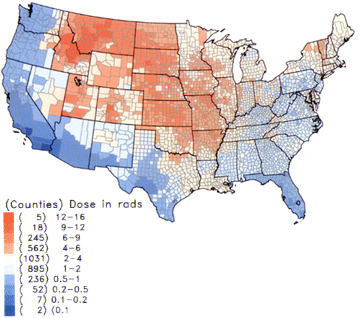Institute for Energy and Environmental Research * Snake River Alliance * Healthy Environment Alliance of Utah * Physicians for Social Responsibility * Alliance for Nuclear Accountability
For immediate release April 28, 2005
Press Release
Advocates welcome National Sciences Academy study recommending expanded compensation for those hurt by U.S. nuclear tests
Groups call on Congress to move quickly to help victims
Groups concerned about the health effects of radioactive fallout welcomed today’s release of a National Academy of Sciences (NAS) report recommending that eligibility for the federal compensation program for people suffering from cancer connected to U.S. nuclear weapons tests not be limited to its current geographic boundaries and urged Congress to move quickly to assist sick downwinders. The NAS study said that Congress should implement science-based changes that, in effect, would extend coverage of the Radiation Exposure Compensation Act (RECA), which is now limited to residents of parts of Nevada, southern Utah and Arizona as well as workers who handled uranium.
“The National Cancer Institute has shown that there were hot spot areas all over the country where milk was contaminated. People with a high risk of thyroid cancer should be compensated without delay wherever they lived without having to jump through hoops,” said Arjun Makhijani, Ph.D., president of the Institute for Energy and Environmental Research (IEER), referring to a 1997 National Cancer Institute (NCI) report on radioactive iodine doses from fallout. “The cancer risks from fallout other than thyroid cancer still need to be determined by careful study. The available science on other cancer risks from testing is inadequate because scientists have not talked to the downwinders carefully enough to determine all the pathways by which they were exposed. For example, radioactive ash deposited after test blasts on laundry as it dried outside could have led to higher exposures than what has been accounted for.”
“The NAS report is a mixed bag,” said Mary Dickson, lifetime resident of Salt Lake City and survivor of thyroid cancer. “It admits that fallout affected the entire country. But it is not possible for many victims to produce hard scientific evidence of their exposure because studies were not done at that time. At this point, all the government has to do is wait for the victims to die.”
Susan Gordon of the Alliance for Nuclear Accountability welcomed NAS’s recognition of the need to include additional geographic areas under RECA. “However,” Ms. Gordon qualified, “under no circumstances should benefits be taken away from the 22 currently eligible RECA counties. Current RECA benefits should not be changed.”
Kimberly Roberts of Physicians for Social Responsibility (PSR) welcomed the NAS recommendation for a broad federal education and communication program about fallout risks. “Patients must have access to information to make informed decisions about their exposures. Congress should include physician education and outreach as part of any new RECA legislation,” Ms. Roberts added.
“RECA funding should not subject to the whims of annual appropriators, so that those who are sick and dying receive a check to pay for their chemotherapy rather than a government IOU,” said Vanessa Pierce of the Healthy Environment Alliance of Utah. “Also, those who were harmed by fallout should receive awards for health damages comparable to the $150,000 payments received by nuclear weapons workers who contracted similar diseases. The public was deliberately misinformed by the government about the health risks of nuclear testing and deserve as much.”
“It’s time for the federal government to make good on its obligation to help all people sickened by U.S. nuclear weapons testing,” Jeremy Maxand, Executive Director of Idaho’s Snake River Alliance, concluded. “The Bush Administration and Congress should focus on making the RECA program work effectively rather than pursuing the dangerous resumption of nuclear weapons tests.”
RECA was originally passed by Congress in 1990 and amended in 2000. The legislation was historic because it was the first time the government publicly acknowledged that downwinders and uranium workers had been hurt and deserved compensation. In the 1950s and early-1960s, the U.S. conducted nearly 100 aboveground nuclear weapons tests. A National Cancer Institute (NCI) study on the health impacts of fallout released in 1997 found that millions of people in the U.S. received significant doses of radioactive iodine and that hot spots occurred thousands of miles from the test sites.
The NAS investigation began in 2002 to assess recent scientific evidence, including the NCI data, to determine whether other groups of people should be covered under the RECA program.
–30–
Attached: NCI map showing areas with radioactive iodine fallout from U.S. nuclear weapons tests.
Attachment
Per capita thyroid doses from NTS tests
Source: NCI 1997
